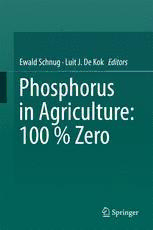
Phosphorus in Agriculture: 100 % Zero PDF
Preview Phosphorus in Agriculture: 100 % Zero
Ewald Schnug · Luit J. De Kok Editors Phosphorus in Agriculture: 100 % Zero Phosphorus in Agriculture: 100 % Zero Ewald Schnug Luit J. De Kok (cid:129) Editors Phosphorus in Agriculture: 100 % Zero 123 Editors Ewald Schnug Luit J.De Kok Institute for Crop andSoilScience Laboratory of Plant Physiology JuliusKühnInstitute University of Groningen Braunschweig Groningen Germany TheNetherlands ISBN978-94-017-7611-0 ISBN978-94-017-7612-7 (eBook) DOI 10.1007/978-94-017-7612-7 LibraryofCongressControlNumber:2016936987 ©SpringerScience+BusinessMediaDordrecht2016 Thisworkissubjecttocopyright.AllrightsarereservedbythePublisher,whetherthewholeorpart of the material is concerned, specifically the rights of translation, reprinting, reuse of illustrations, recitation, broadcasting, reproduction on microfilms or in any other physical way, and transmission orinformationstorageandretrieval,electronicadaptation,computersoftware,orbysimilarordissimilar methodologynowknownorhereafterdeveloped. The use of general descriptive names, registered names, trademarks, service marks, etc. in this publicationdoesnotimply,evenintheabsenceofaspecificstatement,thatsuchnamesareexemptfrom therelevantprotectivelawsandregulationsandthereforefreeforgeneraluse. The publisher, the authors and the editors are safe to assume that the advice and information in this book are believed to be true and accurate at the date of publication. Neither the publisher nor the authorsortheeditorsgiveawarranty,expressorimplied,withrespecttothematerialcontainedhereinor foranyerrorsoromissionsthatmayhavebeenmade. Printedonacid-freepaper ThisSpringerimprintispublishedbySpringerNature TheregisteredcompanyisSpringerScience+BusinessMediaB.V.Dordrecht Ewald Schnug(* 7 September 1954) Thecontributingauthorshavedecidedtodedicatethis book to Ewald Schnug for various reasons. One is his 60th anniversary, yet another one is his outright devotion to fertilizer research that started almost 40 yearsago.ItwastheworkofArmiKaila(1920–2003) ontheapparentutilizationofphosphorusthatinspired himandtriggeredhisambitiontodeliverabenchmark onphosphorusfertilization.Theoutcomeisastandard work, which summarizes cutting-edge knowledge on phosphorus research in different disciplines com- mendable for a mixed spectrum of readers including scientists, farmers, and politicians. It is the compre- hension of these different perspectives into decision-making rules for fertilization, which are the core for a truly balanced use of phosphorus, which is agronomically adequate, environmentally sound, and socio-economically just. Preface Nutrientsinphosphorus(P)fertilizerwhicharecompletely(100%)utilizedbycrop plants without (Zero) contaminating the soil with environmentally relevant sub- stances isa future concept for P fertilization inagriculture. P scarcity is one of the major challenges for agriculture in the near future. The waste of the nonrenewable resource P, which is mainly consumed for fertilization is of major concern for a sustainabledevelopmentandthere isnodoubtthat Pfertilizationstrategiesrequire significant advances towards sustainability. Pessimistic assessments see world P reserveslastonly for another50–150years. Inindustrial countries agriculture uses morePforfertilizationthanitexportswithagriculturalproducts.Someuncertainty inpracticalPfertilizationderivesfromthefactthattherearenoexperimentalmeans to estimate the true long-term utilization of fertilizer P. The traditional concepts (differential andradioisotope method) suggest thaton anaverage only 75 %ofthe fertilizer P applied is finally used by plants, implicating that always more P has to be fertilized than will be recovered by agricultural products. Next to P scarcity, excessive P loads on soils with intensive livestock farming and use of P sources, whicharenotcompletelyavailableforplantresultinevitablyinadissipationofthis nonrenewable resource. Yet, another problem is the guidelines for site-specific P fertilizer recommendations in relation to land use systems. Thebreakthroughtowardsanunderstandingfortheprerequisitesforacomplete P utilization and thus also a complete recycling of fertilizer P came with an empirical approach published in 1965 by the Finnish scientist Armi Kaila (1920– 2003),forwhichtheterm“apparentutilization”hasbeencoined.BasedonKaila’s hypothesis,Pfertilizationconceptscanbedesigned,whichwarrantafullutilization offertilizer P in agriculture. This book agglomerates the basic knowledge required to target a 100 % P utilization which comprises the basic concept of “apparent utilization”, the fundamental principles of P turnover in soils and plants, the evaluation of the P nutritional status, and characteristics of fertilizers and fertil- ization concepts whereby the latter is addressed on national level. Secondtothegoal ofa100%utilization offertilizerPistheobjectivetoavoid or at least to limit the soil contamination and accumulation of hazardous inorganic vii viii Preface and organic substances coming with the various types of P fertilizers. What seems likecuttingtheGordianknotmaybeachallengeforfuturedevelopmentinfertilizer manufacturing technology, energy neutral P fertilizer production using high-temperature nuclear reactors, where the energy required to make a clean fer- tilizer comes with the raw material. Last but not least, this book addresses one of the first not only basic issues of sustainability of P fertilization but also its socio-economic aspects and proposed governance instruments. Braunschweig, Germany Ewald Schnug Groningen, The Netherlands Luit J. De Kok “ ” Phosphora Ahand-sewntextilecollagefromcottonandsilk(44×42cm)byBettinaFranckenberg,Bodrum, Turkey(2016) ix x “Phosphora” InsearchfortheelusivePhilosopher’sstone,whichturnsordinarymetalintogold, Henning Brand discovered in 1669 the element phosphorus. Alchemists of that timeoftenusedlightasasymbolofthespirit.Thustheywereespeciallyinterested in light that seemed to be trapped in matter and their vision was coupled into the idea of a perpetual, eternally burning light. The light emanated from phosphorus inspired a few artists: in E.T.A. Hoffmann’s fairy tale “The Golden Pot” (1814), thelucent,obviouslymale,“Phosphorus”fightswithablackdragonandinBettina Franckenberg’s “Phosphora” his female sibling debuts in form of a sphere of radiatinglightandluminosityinalldirections.Thestitchedthreadsdirecttheway, the soft fabric nestles to flowing vibes, and the beads symbolize notions clear as crystals. The interplay of these elements reflects Phosphora’s impression as spir- ited light. Children and open-minded are close to her heart, she empowers thewill to live and her spiritual strength promises healing. About the Artist BettinaFranckenbergwasborninFebruary 3, 1956 in Essen, Germany. Handcraft and artisticabilitieswereencouragedearlyinher parent’s house. After graduating from col- lege in 1975 she continued with her educa- tion in the field of occupational therapy, graduated in 1979, and started to specialize in psychiatry, supplementary qualification as psychodrama assistant—at the same time initiation to “patchwork”. In 1982 she dis- covered the Mediterranean (living the first 2 years in Greece) as well as her “textile ambitions”—1986 she opened her first exhibition in the Castle of St. Peter in Bodrum. She went back to live in Berlin for some years—between 1989 and 1992 she worked as an occupational therapist in psy- chiatry and organized several “textile art” exhibitions in Germany, Switzerland, Latvia, and Turkey. Since 1992, Bettina Franckenberg has been living permanently in Bodrum, Turkey and between 1994 and 2005 she had her own Atelier-Gallery in the holiday-village Sea-Garden in Yaliçiftlik. She continues working as a freelance textile artist living in Kizilagac near Bodrum. Her first artwork on a scientific subject was “Uranyum“, a hand-sewn textile collagefromvelvetandsilk(38×37cm)whichappearedonthecoverofthebook “Loads and Fate of Fertilizer Derived Uranium”. Edited by L.J. De Kok and E. Schnug (2007), Backhuys Publishers, Leiden, The Netherlands. “Phosphora” xi
